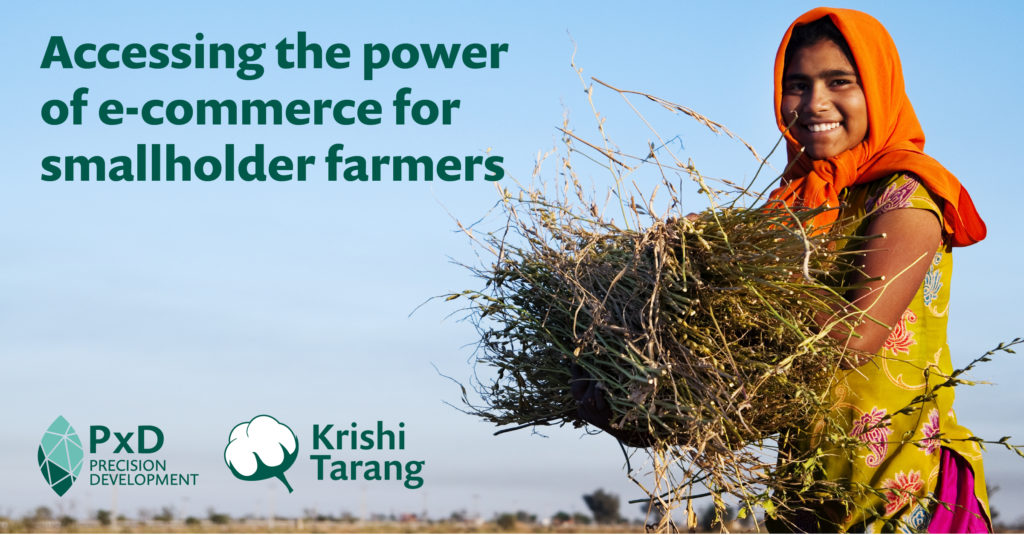Accessing the Power of E-Commerce for Smallholder Farmers
- October 20, 2021
- 11 minutes read
Can e-commerce address constraints that inhibit growth and productivity among Indian smallholder farmers? Rohit Goel, a Research and Operations Associate on PxD’s India Team, investigates and traces the contours of an exciting PxD pilot in Gujarat which aims to connect smallholder farmers to online vendors and marketplaces.

E-commerce – the buying and selling of goods and services over an electronic network – has transformed business operations in India. In 2020, the market size of e-commerce in India was assessed at 64 billion USD in 2020 and is expected to rise to 200 billion USD by 2027. This rapid growth in e-commerce has the potential to address long-standing deficiencies in the Indian agricultural sector, and transform Indian agriculture – a sector that accounts for 18.3% of India’s GDP (2020) and is the primary source of income for a majority of Indian households. This opportunity presents itself at a time when the sector is declining in productivity due to a range of challenges including a constrained supply of inputs, inefficient sales markets, and low levels of competition among intermediaries across supply chains. However, India’s agriculture sector is poorly positioned to capitalize on the opportunities presented by e-commerce due to challenges confronting smallholder farmers in rural areas, such as low levels of digital literacy, poor ICT infrastructure, a lack of familiarity with digital transactions, and inequitable access to smartphones and/or the internet.
Precision Development (PxD) is well-positioned to assist firms and farmers overcome these and other access and market-related challenges. With support from the Swiss Re Foundation, we are utilizing our voice-based, two-way information exchange service – dubbed Krishi Tarang – to pilot an initiative to inform farmers about, and connect them with, a variety of businesses that address unmet needs at different points across the agricultural value chain – including, but not limited to, input suppliers, crop offtakers, lending agencies, crop insurance providers, soil testers, and carbon traders. Krishi Tarang operates using Paddy, PxD’s in-house communications platform, and is compatible with very basic mobile phones that lack internet capabilities. The pilot will also explore revenue generation opportunities to support the scaling of free, customized, and timely agricultural advisory services to smallholder farmers and endeavors to complement the work of other not-for-profit organizations working to improve farmer livelihoods so that their farmers can take advantage of these new partnerships too.
Creating an online ecosystem for smallholder and village farmers
With support from the Swiss Re Foundation, PxD is working to holistically address farmer needs by creating an ecosystem of private partners along the agricultural value chain. Moreover, we are investigating ways in which new partnerships can generate revenue to support free digital agricultural advisory services for smallholders. The successful implementation of an integrated service offering at scale has the potential to reduce farmers’ overall costs while enhancing their revenues. We also hope that this initiative will generate new insights that help us to make our advisory service more relevant and, by extension, improve adoption rates of PxD’s recommendations among farmers.
Since December 2020, PxD has run a pilot project with farmers registered on our Krishi Tarang advisory service in Gujarat. As part of the pilot, PxD contacts farmers via channels, such as automated and live calls, to promote the services of our partners. Farmers who show interest in a particular service are then connected to service providers. PxD takes a nominal commission on every successful transaction initiated by Krishi Tarang farmers and, in certain instances, a fixed fee for connecting each new farmer. In this way, PxD’s farmers can connect with a series of legitimate e-commerce partners to access various goods and services such as business development and market linkages, agricultural inputs, financial support, and field-level technology. Since the farmers do not need an internet connection or smartphone to access these services, we can circumvent some persistent barriers to entry and access, and connect marginal and smallholder farmers to online vendors. We hope that competition among vendors will improve and draw an increased number of users and service providers to the village and smallholder marketplace.
E-commerce’s transformative potential
In 2016, 59% of India’s workforce was employed in agriculture. In rural areas, dependence on farming activity is widespread, with 70% of households relying on agriculture to support their livelihoods. According to the Food and Agriculture Organization (FAO), 82% of India’s farmers are small and marginal farmers. Despite the importance of agriculture for so many Indian households, the contribution of agriculture to GDP has fallen precipitously in recent decades, declining from 41.3% in 1960 to 18.3% in 2020. Given the large share of Indian households that continue to depend on agriculture to support their livelihoods, and the number of poor households dependent on the fortunes of the sector in particular, declining productivity and profitability in the sector is a significant concern.
E-commerce has the potential to address several challenges constraining the performance of India’s agriculture sector by creating new links between participants along the agricultural value chain. Examples of potential benefits include:
- Waste reduction: According to the Food and Agriculture Organization (FAO), a third of food produced for human consumption is wasted. A study by the Indian Council of Agricultural Research in 2016 reported losses of approximately 5.5% for cereals, pulses, and oilseeds, and approximately 11% for fruits and vegetables, due to waste during harvesting, post-harvesting, handling, and storage. Agriculture e-commerce services can reduce post-harvest waste by minimizing the number of intermediaries farmers need to liaise with, improve access to more efficient transportation, and quicker access to quality storage facilities. At the aggregate level, these effects can substantially reduce the time it takes for produce to reach consumers.
- Overcoming information asymmetries: There is some evidence that mobile phones improve farmers’ access to information with potentially positive implications for their incomes, although the findings are mixed. Muto & Yamano (2009) found that increased phone coverage in rural Uganda, between 2005 and 2009, was associated with a higher probability of banana sales and an increase in the sale price of bananas. However, this pattern was not evident for maize, a non-perishable crop, suggesting that price information may be more important for products with a shorter shelf life. Jensen (2007) found that the introduction of mobile phones in Kerala was associated with an increase of 8% in fishermen’s profits, driven by reduced wastage. However, other papers have found little impact of ICT on farm prices and farmer income. For example, Aker and Fafchamps (2015) examined mobile phone expansion in Niger, and Futh and McIntosh (2009) examined the introduction of village phones in Rwanda. Neither evaluation found evidence that increased access to phones was associated with price changes.
- Financial inclusion: When agricultural e-commerce platforms store transaction records, they may offer farmers an opportunity to build a “digital history” that could, in turn, allow them to demonstrate farmers’ creditworthiness to financial service providers. Francis, Blumenstock and Robinson (2017) identified credit scores, captured from the historical user data using mobile phones, as one of the major factors leading to creating a digital credit system. Digital credit lowers transaction time and reduces costs compared to conventional credit, and borrowers generally do not need collateral to be approved for digital loans. According to GSMA’s report, in 2018, 866 million people have mobile money accounts processing 1.3 billion USD daily. Sub-Saharan Africa accounted for 45.6% of the mobile money activity in the world; and technology companies, credit bureaus, and banks are opting for smartphone digital credit scoring for their business.
- Improved cost and market efficiency: The potential economic benefits of agriculture e-commerce may serve as an incentive for farmers to increase their on-farm investments and productivity. In addition, farmers may gain access to higher-quality inputs through online suppliers than they can find in their local markets. For example, Bergquist and McIntosh (2021) find that the introduction of a mobile phone-based marketplace for agricultural produce in Uganda led to increased trade flows and reduced-price dispersion across markets, generating a cost-effective increase in farmer profits.
Ongoing Challenges
Agritech startups and other private firms are leveraging technology to provide farmers with access to new input suppliers and improve linkages to output markets. The market for digital agriculture services in India has grown rapidly in the past few years, with companies like Ninjakart, Big Basket, Grofers Agrostar, and BigHaat raising millions of dollars in start-up capital.
Despite the actions of these and other stakeholders, and evidence of benefits associated with e-commerce, the take-up of e-commerce services to support the agricultural sector in India has been limited. Key challenges include:
- Rural India lacks infrastructure for e-commerce. 70% of the rural households do not have an active internet connection, and only 4.4% of rural households own a computer.
- Middlemen continue to play a dominant role in agriculture markets and rural economies. Poor market linkages increase transaction costs and post-harvest losses. Poor market development enables middlemen to dominate critical roles and transactions across the supply chain in such a way that only a very small share of the final sales price reaches smallholder farmers. Moreover, middlemen and money lenders at the local level may function as local monopolies, further depressing farmers’ bargaining power and the prices paid for produce.
- Underdeveloped cold chains and long transportation times limit the transport of perishable goods, increase post-harvest losses and constrain market development.
- Farmers are unable or reluctant to adapt to online opportunities. PxD conducted qualitative interviews with 119 farmers registered on PxD’s service in Gujarat and Haryana in March, April, and May of 2021. Ninety-six percent of respondents reported that they bought their inputs locally, citing the quality of the inputs received, trust in the seller, and credit availability as their reasons for doing so. Only 13 farmers (11%) had ever purchased agricultural inputs online.
- In 2018, more than 19,500 languages or dialects are spoken by Indians as their mother tongue. The diversity of spoken and written languages and cultures makes it difficult for small firms to scale their services.
- While access to financial services has increased throughout the country in recent years – in 2017, 80% of adults had an account at a bank or other financial institution, more than twice the rate of account ownership in 2011, which was 35% – access to credit remains limited. And, while credit does not seem to be the primary constraint hindering farmers’ profits, credit products that are specifically designed to address farmers’ unique needs have been found to increase agricultural investment, output, and revenues (though impacts are affected by contextual factors like unpredictable price fluctuations and farmers’ relationships with traders). Limited borrowing ability may prevent farmers from taking advantage of the opportunities that e-commerce presents.
- Small, early-stage firms may struggle to enter and survive in the market. MicroSave Consulting highlights three key challenges confronting start-ups in India: Investors have limited willingness to offer long-term capital in a context in which agricultural investments typically take time to offer returns. Second, agricultural e-commerce may require partnering with the banks or government players, which impose operational hurdles. Third, agriculture-related data, required for many start-ups to identify and reach the farmers who might benefit from their services, can be difficult for new players to access.
Promising progress!
Leveraging this pilot, PxD aims to more systematically understand opportunities for, and constraints to, establishing an ecosystem of free agricultural advisory with a spectrum of agricultural and allied private organizations and service providers. By October 2021, PxD had signed partnership agreements with three input supply companies (BigHaat, Agrostar, and Behtar Zindagi), three market linkage organizations (Agri10x, Impagro, and Fruitfal); and we are actively discussing partnership opportunities with six other private sector firms that cater to different farmer needs across the cropping cycle from pre- to post-harvest.
There is growing interest among other farmer-facing non-profit organizations to join PxD so that farmers enrolled in their structures and services can benefit from this expanding ecosystem of private sector partners. In the medium term, we hope that government entities focused on improving agricultural outcomes will support similar models of engagement. We are confident that the development of such an ecosystem of non-profit, non-governmental, private, and public organizations will be effective in holistically addressing farmer needs in a cost-effective and more impactful manner.

Stay Updated with Our Newsletter

Make an Impact Today


